


xxxxxThe three Bronte sisters, Charlotte, Emily and Anne, were daughters of an eccentric Anglican clergyman who was Rector of Haworth on the bleak Yorkshire moors. Isolated from society in general, and beset by poverty and ill-
THE BRONTE SISTERS (G3c, G4, W4, Va)
CHARLOTTE BRONTE 1816 -
EMILY BRONTE 1818 -
ANNE BRONTE 1820 -
Acknowledgements
Bronte sisters: by their brother Patrick Branwell Bronte (1817-
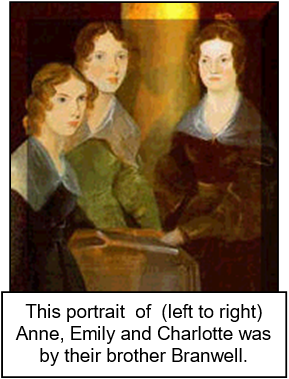 xxxxxThe remarkable Bronte sisters, Charlotte, Emily and Anne, were the daughters of the Reverend Patrick Bronte, the Rector of Haworth, a remote village on the desolate Yorkshire moors. They were brought up by an aunt in the lonely, bleak atmosphere of the rectory, but all three possessed lively minds and imaginations, and were destined to produce outstanding novels, the subject matter of which went far beyond the scope of their daily experience. Tragically, both Emily and Anne succumbed to tuberculosis, along with their brother Branwell, in late 1848 and early 1849. Charlotte married her father’s curate, Arthur Bell Nicholls, in 1854, and died during pregnancy the following year.
xxxxxThe remarkable Bronte sisters, Charlotte, Emily and Anne, were the daughters of the Reverend Patrick Bronte, the Rector of Haworth, a remote village on the desolate Yorkshire moors. They were brought up by an aunt in the lonely, bleak atmosphere of the rectory, but all three possessed lively minds and imaginations, and were destined to produce outstanding novels, the subject matter of which went far beyond the scope of their daily experience. Tragically, both Emily and Anne succumbed to tuberculosis, along with their brother Branwell, in late 1848 and early 1849. Charlotte married her father’s curate, Arthur Bell Nicholls, in 1854, and died during pregnancy the following year.
xxxxxThe Reverend Patrick Bronte, an eccentric Anglican clergyman of Irish birth, moved with his wife and six small children to Haworth in 1820. A few years later his wife and his two eldest daughters, Maria and Elizabeth, died, and he was left to bring up his remaining children, assisted by his sister-
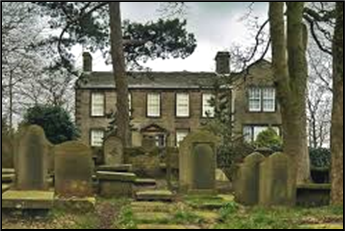 xxxxxIn 1824, Charlotte, accompanied by Emily, was sent to the Clergy Daughters School at Cowan Bridge, near Kirkby Londsdale in Lancashire, (where Maria and Elizabeth were already boarders) and it was this school, with its harsh discipline and poor food, which featured later in her novel Jane Eyre, disguised under the name of Lowood. With the death of Maria and Elizabeth in 1825, both Charlotte and Emily were brought home, and for the next five years the four children were virtually left to their own devices. These proved highly formative years, during which they wrote and told romantic stories and poems to each other, and devised a variety of imaginative games, some carried out in the churchyard or upon the bleak, desolate moorland which surrounded the rectory at Haworth (illustrated). A set of wooden soldiers inspired the characters for some of their fantasy “creations”. Charlotte, together with her brother Branwell, conjured up elaborate tales of adventure, set in the make-
xxxxxIn 1824, Charlotte, accompanied by Emily, was sent to the Clergy Daughters School at Cowan Bridge, near Kirkby Londsdale in Lancashire, (where Maria and Elizabeth were already boarders) and it was this school, with its harsh discipline and poor food, which featured later in her novel Jane Eyre, disguised under the name of Lowood. With the death of Maria and Elizabeth in 1825, both Charlotte and Emily were brought home, and for the next five years the four children were virtually left to their own devices. These proved highly formative years, during which they wrote and told romantic stories and poems to each other, and devised a variety of imaginative games, some carried out in the churchyard or upon the bleak, desolate moorland which surrounded the rectory at Haworth (illustrated). A set of wooden soldiers inspired the characters for some of their fantasy “creations”. Charlotte, together with her brother Branwell, conjured up elaborate tales of adventure, set in the make-
xxxxxIn 1831 Charlotte was sent to a school at Roe Head, near Huddersfield. She studied there for a year, and then returned in 1835 as a teacher in order to make some money and set Branwell on his career as an artist. She held the post for three years, but found the work uncongenial, and longed to make her own way in life. She left in 1838 and, after working as a governess for a while, planned, along with Emily, to set up a school at the parsonage. With this in mind the two sisters travelled to Brussels in 1842 to improve their French. The school itself never got off the ground, but Charlotte’s two year stay in Brussels introduced her to the outside world, provided her with a deal of material for her future novels (notably Villette and The Professor), and broadened her personal relationships -
xxxxxShe returned to Haworth in 1844. By this time her aunt Elizabeth had died, her father was gradually losing his sight, and her brother, failing as an artist, had taken to drink and opium. But it was during these troubled years that literary success was achieved. In 1846 the three sisters published, at their own expense, a joint volume of Poems under the pseudonyms Currer Bell (Chartlotte), Ellis Bell (Emily) and Acton Bell (Anne). Only two copies were sold in fact, but the following year saw the production of their now famous novels and, once the authors’ identities were known, the works of the Bronte sisters took their place among the gems of English literature.
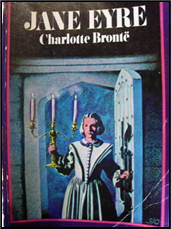
xxxxxCharlotte’s novel, Jane Eyre, was published in October 1847 and was an immediate success. Written in the first person, it tells of an orphan girl who, becoming a governess, falls in love with her employer, the moody, enigmatic Edward Rochester. What follows is romantic melodrama, but it gripped the attention of the readers of the day and, by its sensitive portrayal, has remained a popular novel ever since. It is, above all, a powerful declaration of feminism, portraying love from a woman’s perspective, as well as the struggle faced by women in their quest for recognition and independence.
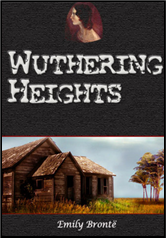 xxxxxBut Emily’s novel Wuthering Heights, a passionate, wild love story set amid the desolate, storm-
xxxxxBut Emily’s novel Wuthering Heights, a passionate, wild love story set amid the desolate, storm-
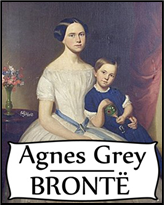
xxxxxAnne’s Agnes Grey and her novel of the following year, The Tenant of Wildfell Hall, whilst not showing such outstanding talent as that of her older sisters, revealed a remarkable skill in personal observation. The first was centred around the life of a governess, and the second gave a candid account of a young man’s decline into drunkenness and debauchery, a somewhat surprising subject for a person of such a gentle and pious nature, but doubtless influenced by the troubled life of her brother Branwell.
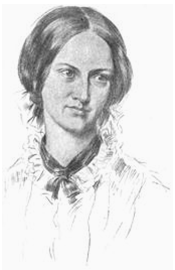
xxxxxBut for the Bronte sisters, the happiness which came with success proved short-
xxxxxBut in spite of such tragic bereavements, Charlotte was determined to carry on. Between her household chores, she resumed her writing, and in October 1849 produced Shirley, a regional novel which, whilst lacking the romantic impact of Jane Eyre, gave a realistic, shrewdly written account of the troubles between master and worker in the Yorkshire weaving industry. She followed this with Villette in 1853, and The Professor, published posthumously in 1857, two works which drew heavily upon the troubled time she had spent in Brussels in the early 1840s. During this productive period she paid three visits to London, where she made the acquaintance of a number of literary figures, including William Makepeace Thackeray and Matthew Arnold, and she also travelled to see friends in the north of England. It was there in 1850 that she met Elizabeth Gaskell, the novelist who wrote her first biography in 1857.
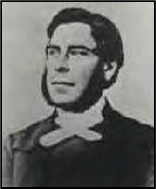
xxxxxInxJune 1854, having turned down several offers of marriage from past suitors, she married her father’s curate, the Irishman Arthur Bell Nicholls (1819-
xxxxxThe novels of the three Bronte sisters, noted above all for their depth of insight, feeling and passion, are the more remarkable because of the restricted lives led by their authors. Isolated in the depths of the Yorkshire moors, and beset by poverty and ill-
xxxxxIncidentally, while at school at Roe Head in the early 1830s, Charlotte made a number of friends, including one named Ellen Nussey (1817-
xxxxx…… Charlotte’s novel Shirley, published in 1849, contains a graphic account of the attack the Luddites made on the mill at Rawfolds in 1812 in which four of the raiders were shot dead. ……
xxxxx…… In 2011, a little book of nineteen pages -
xxxxx…… The Reverend Bronte was a somewhat strange, stern man. He certainly instilled in his daughters a love of books and writing, but he was opposed to them having any feminine finery, and, by all accounts, insisted on a diet of potatoes in the belief that this made them hardy. ……
xxxxx…… The Rectory at Haworth, where the sisters were brought up, is now a museum, dedicated to their lives and works, and there is a joint memorial to all three in Westminster Abbey, London. All the family are buried in Haworth Church except for Anne, who is buried in the seaside resort of Scarborough, where she had gone to convalesce.
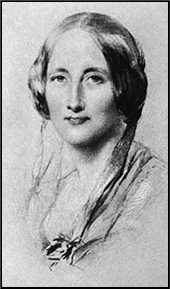 xxxxxThe novelist Elizabeth Gaskell (1810-
xxxxxThe novelist Elizabeth Gaskell (1810-
xxxxxGaskell was born in London, but was brought up by an aunt in the small Cheshire village of Knutsford. She married William Gaskell, a Unitarian minister, in 1832 and from then on gave much of her time to helping the poor and needy in the slums of Manchester. In 1848 she gained literary fame with her novel Mary Barton,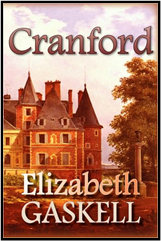 a work describing in harrowing detail the plight of the working classes in the city’s expanding industries. Her most popular novel, Cranford, published in instalments from 1853, and providing a series of sketches of life in a small northern town, was closely modelled on her early days in Knutsford. Among her other novels were The Moorland Cottage of 1850, Ruth of 1853, and North and South, published in 1855, another “utterance”, as she put it, on behalf of the poor. Her concern with social issues won her the friendship of Charles Dickens, and her works were particularly admired by the politician Benjamin Disraeli and the writers Thomas Carlyle and William Thackeray.
a work describing in harrowing detail the plight of the working classes in the city’s expanding industries. Her most popular novel, Cranford, published in instalments from 1853, and providing a series of sketches of life in a small northern town, was closely modelled on her early days in Knutsford. Among her other novels were The Moorland Cottage of 1850, Ruth of 1853, and North and South, published in 1855, another “utterance”, as she put it, on behalf of the poor. Her concern with social issues won her the friendship of Charles Dickens, and her works were particularly admired by the politician Benjamin Disraeli and the writers Thomas Carlyle and William Thackeray.
Including:
Elizabeth Gaskell

Va-


